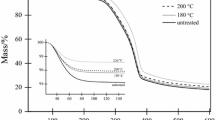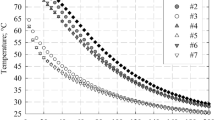Abstract
Thermal treatments of beech wood with different temperature loads on the wood cause characteristic changes in the chemical composition. The determination of specific changes was carried out by means of suitable methods, both wet chemical and instrumental analyses. It could be confirmed that in addition to the degradation of polyoses, lignin, known as the thermally most stable compound, shows significant thermal alterations too.










Similar content being viewed by others
References
Ayadi N, Lejeune F, Charrier F, Charrier B, Merlin A (2003) Color stability of heat-treated wood during artificial weathering. Holz Roh- Werkst 61:221–226
Boonstra M, Pizzi A, Zomers F, Ohlmeyer M, Paul W (2006a) The effects of a two stage heat treatment process on the properties of particleboard. Holz Roh- Werkst 64:157–164
Boonstra M, van Acker J, Kegel E, Stevens M (2006b) Optimisation of a two-stage heat treatment process: durability aspects. Wood Sci Technol 41:31–57
Faix O (1992) Fourier transform infrared spectroscopy. In: Lin SY, Dence CW (eds) Methods in lignin chemistry. Springer, Berlin, pp 83–109
Fengel D, Wegener G (1979) Hydrolysis of polysaccharides with trifluoroacetic acid and its application to rapid wood and pulp analysis. In: Brown Jr RD, Jurasek L (eds) Hydrolysis of cellulose: mechanisms of enzymatic and acid catalysis (Adv. Chem. Ser. No. 181 ACS), pp 145–158
Fengel D, Wegener G (2003) Wood: chemistry, ultrastructure, reactions. Reprint Kessel, http://www.forstbuch.de, Remagen
Follrich J, Müller U, Gindl W (2006) Effects of thermal modification on the adhesion between spruce wood (Picea abies Karst.) and a thermoplastic polymer. Holz Roh- Werkst 64:373–376
Haw JF, Schultz TP (1985) Carbon-13CP/MAS NMR and FT-IR study of low-temperature lignin pyrolysis. Holzforschung 39:289–296
Kacik F, Melcer I, Melcerová A (1992) Vergleichende Charakteristik einer hydrothermischen und thermischen Behandlung von Buchenholz. Holz Roh- Werkst 50:79–84
Kamdem D, Pizzi A, Jermannaud A (2002) Durability of heat-treated wood. Holz Roh- Werkst 60:1–6
Kotilainen RA, Toivanen TJ, Alén RJ (2000) FTIR monitoring of chemical changes in softwood during heating. J Wood Chem Technol 20:307–320
Lapierre C, Monties B, Rolando C (1986) Thioacidolysis of popular lignins: identification of monomeric syringyl products and characterization of guaiacyl–syringyl lignin fractions. Holzforschung 40:113–118
Månsson P (1983) Quantitative determination of phenolic and total hydroxyl groups in lignin. Holzforschung 37:143–146
Månsson P, Samuelsson B (1981) Quantitative determination of O-acetyl and other O-acyl groups in cellulosic material. Svensk Papperstidning 84:R15–R24
Marques AV, Pereira H, Meier D, Faix O (1999) Structural Characterization of cork lignin by thioacidolysis and permanganate oxidation. Holzforschung 53:167–174
Nakano T, Miyazaki J (2003) Surface fractal dimensionality and hygroscopicity for heated wood. Holzforschung 57:289–294
Nuopponen M, Vuorinen T, Jämsä S, Viitaniemi P (2004) Thermal modifications in softwood studied by FT-IR and UV resonance raman spectroscopies. J Wood Chem Technol 24:13–26
Önnerud H, Gellerstedt G (2003) Inhomogeneities in chemical structure of hardwood lignins. Holzforschung 57:255–265
Paul W, Ohlmeyer M, Leithoff H (2007) Thermal modification of OSB-strands by a one-step heat pre-treatment—influence of temperature on weight loss, hygroscopicity and improved fungal resistance. Holz Roh- Werkst 65:57–63
Pietarinen S, Willför S, Sjöholm R, Holmbom B (2005) Bioactive phenolic substances in important tree species. Part 3. Knots and stemwood of Acacia crassicarpa and A. mangium. Holzforschung 59:94–101
Rolando C, Monties B, Lapierre C (1992) Thioacidolysis. In: Lin SY, Dence CW (eds) Methods in lignin chemistry, Springer, Berlin, pp 334–349
Sivonen H, Maunu S, Sundholm F, Jämsä S, Viitaniemi P (2002) Magnetic resonance studies of thermally modified wood. Holzforschung 56:648–654
Stamm B, Windeisen E, Natterer J, Wegener G (2006) Chemical investigations on the thermal behaviour of wood during friction welding. Wood Sci Technol 40:615–627
Tjeerdsma BF, Boonstra M, Pizzi A, Tekely P, Militz H (1998) Characterisation of thermally modified wood: molecular reasons for wood performance improvement. Holz Roh- Werkst 56:149–153
Ucar G, Meier D, Faix O, Wegener G (2005) Analytical pyrolysis and FTIR spectroscopy of fossil Sequoiadendron giganteum (Lindl.) wood and MWLs isolated hereof. Holz Roh- Werkst 63:57–63
Weiland J, Guyonnet R (2003) Study of chemical modifications and fungi degradation of thermally modified wood using DRIFT spectroscopy. Holz Roh- Werkst 61:216–220
Wienhaus O (1999) Modifizierung des Holzes durch eine milde Pyrolyse – abgeleitet aus den allgemeinen Prinzipien der Thermolyse des Holzes. Wissenschaftl Zeitschr Univ Dresden 48:17–22
Windeisen E, Wegener G (2005) Behaviour of lignin during thermal treatments. Proceedings of 7th ILI Forum, Barcelona 27–28 April, pp 141–143
Windeisen E, Strobel C, Wegener G (2003) Chemische Charakterisierung von thermisch belastetem Holz: Bestimmung des Acetylgruppengehalts und FTIR Spektroskopie. Holz Roh- Werkst 61:471–472
Zaman A, Alén R, Kotilainen R (2000) Thermal behaviour of Scots pine (Pinus sylvestris) and silver birch (Betula pendula) at 200–230°C. Wood Fibre Sci 32:138–143
Acknowledgments
Special thanks are due to Prof. Dr. Bernhard Zimmer (FH Salzburg) for providing the wood samples and in particular to Astrid Thönnißen at Wood Research Munich for performing part of the chemical analyses.
Author information
Authors and Affiliations
Corresponding author
Rights and permissions
About this article
Cite this article
Windeisen, E., Strobel, C. & Wegener, G. Chemical changes during the production of thermo-treated beech wood. Wood Sci Technol 41, 523–536 (2007). https://doi.org/10.1007/s00226-007-0146-5
Received:
Published:
Issue Date:
DOI: https://doi.org/10.1007/s00226-007-0146-5




